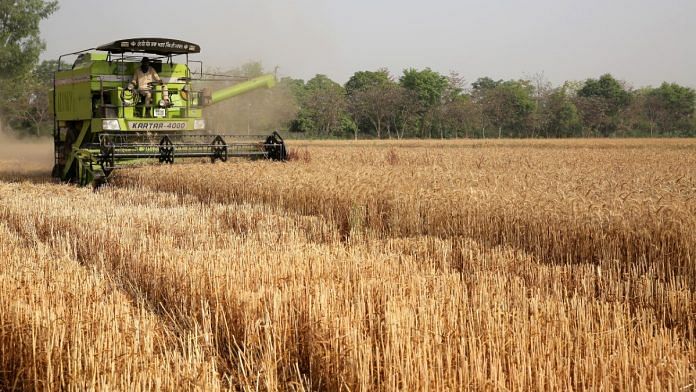New Delhi: Rising wholesale and consumer prices of wheat may push India to allow imports of the staple food item in a few months’ time. If India turns importer, it will be a drastic reversal — from desiring to ‘feed the world’ in the summer to battling a shortfall by winter.
Compared to last year (2021-22) when India exported about 7.2 million tonnes of wheat, exports are estimated to be 6 million tonnes by the end of the ongoing financial year (2022-23).
India announced an export ban in May this year to ensure domestic availability of the cereal and tame food inflation.
But data from the Ministry of Consumer Affairs, Food & Public Distribution shows that wheat prices are skyrocketing. As on August 6, average retail and wholesale wheat flour (atta) prices for the entire country were 14 per cent and 19 per cent higher, respectively, year-on-year.
Retail wheat flour prices were 21 per cent higher in Delhi, 29 per cent higher in Mumbai and a staggering 46 per cent higher in Kolkata, compared to last year, as on August 5.
In contrast, international wheat prices fell by 14.5 per cent in July (month-on-month), partly due to the agreement between Russia and Ukraine to unblock ports in the Black Sea region to allow exports of Ukrainian grain.
As international prices soften and domestic prices rise, India could end up allowing wheat imports, traders said.
Government stocks of wheat are only marginally above what it requires for the food subsidy schemes and strategic reserves. As on 22 July, India had 27.8 million tonnes of wheat in public stocks against the stocking norm of 27.6 million tonnes. Current stocks are at their lowest in 14 years.
The government maintains that the wheat situation is under control.
ThePrint reached food secretary Sudhanshu Pandey via email and text but received no response. This report will be updated as and when a response is received.
“Public procurement (of wheat) this year was lower compared to previous years but we have enough stocks of rice and wheat… We can intervene if prices cross a limit… we are monitoring the situation closely and will take steps in the national interest when required,” food secretary Sudhanshu Pandey had said in an interview to CNBC Awaaz earlier this week.
Siraj Hussain, a former agriculture secretary, told ThePrint that retail wheat flour (atta) prices have shot up by over 20 per cent in major metros. “No government can be comfortable with such a steep increase in prices of a staple cereal, especially when rains have been deficient in major rice growing states,” he said.
“If prices rise further, there is every possibility that the import duty on wheat will be abolished,” added Hussain, who is also a former managing director of the Food Corporation of India (FCI).
Risks to rice production in the ongoing Kharif crop season have further added to the worsening wheat situation.
Owing to deficit rains and lower plantings in states like Uttar Pradesh, Bihar, West Bengal and Jharkhand, India’s rice production could drop by around 10 million tonnes in 2022-23.
Also Read: Food worries mount for India, as erratic monsoon rains cause 13% lag in area under paddy
Contested estimates
Wholesale mill-quality wheat prices rose from Rs 2,200 per quintal in April, before the ban was announced, to about Rs 2,500 per quintal by early August, said Sandeep Bansal, a wheat flour mill owner from Uttar Pradesh, the largest wheat producing state.
These prices could touch Rs 2,800 – Rs 3,000 per quintal by October-November, likely forcing the government to reduce import duties and announce steps like stock limits on traders, Bansal added.
At present, India imposes a 40 per cent duty on wheat imports.
Whether India will need to import wheat depends on which estimate of production is correct.
In February, the agriculture ministry estimated the 2022 wheat harvest at a record 111 million tonnes. In April, after a freak heatwave led to a yield drop in major growing states, the ministry cut production estimates to 106.4 million tonnes, the lowest in three years.
The United States Department of Agriculture’s Foreign Agricultural Service estimated the crop size in India to be at 99 million tonnes in May.
However, traders and mill owners say the actual crop could be much lower, in the range of 90-95 million tonnes.
“Current wheat prices are not supporting the government’s production estimate. The actual number could be somewhere close to 90 million tonnes. The supply shortfall is the reason behind the supply-demand imbalance and current high prices,” said Dhaval Meghpara, director of Gujarat-based Vanraj Besan and Roller Flour Mill.
Meghpara added that despite the recent drop in global wheat prices, international wheat prices are higher than domestic prices.
“But if the government doesn’t act, domestic prices will move up by the Diwali festive season when demand surges. What the government needs to do is to plan and reveal a strategy to the market and not create a sudden frenzy,” he said.
A Delhi-based trader who did not wish to be named, said import of wheat will “come at a cost”.
“Last year, India exported wheat at an average price of US $275 per ton and this year it could import at prices above US $400 per ton,” said the trader, adding that it is likely that domestic wholesale wheat prices will “reach Rs 3,000 per quintal by November”.
“A lot will depend on whether the government extends the free food scheme (Pradhan Mantri Garib Kalyan Anna Yojana) beyond September and if it will relax stocking norms and undertake open market sales (from its stocks) to cool prices.”
(Edited by Amrtansh Arora)
Also Read: Chicken or egg, farmer comes last in India’s wildly swinging poultry business



